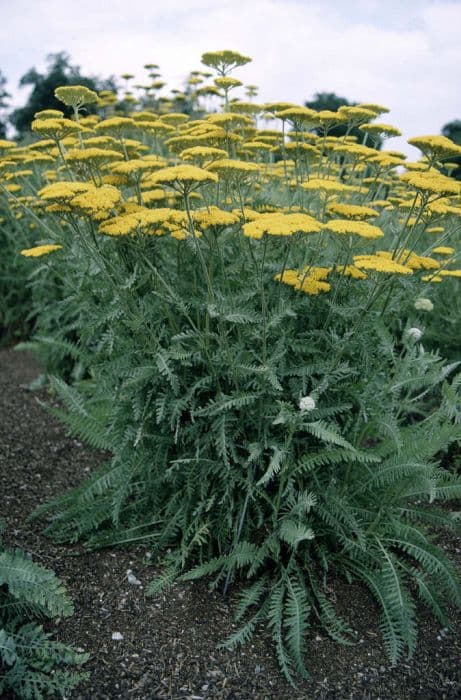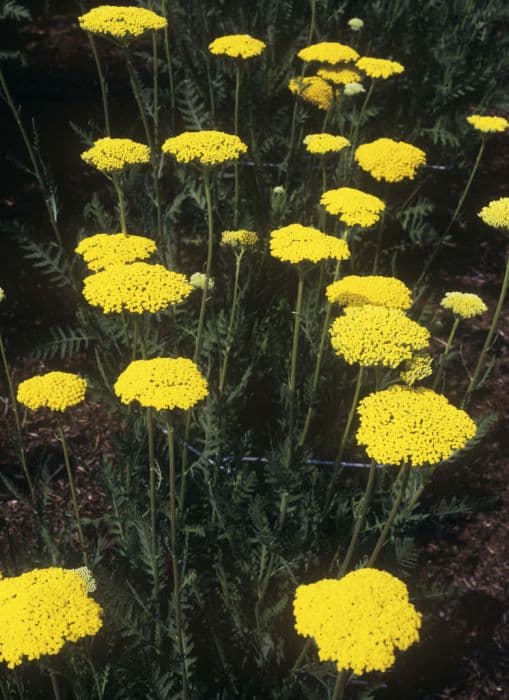Italian Aster Aster amellus 'Brilliant'
ABOUT
Aster amellus 'Brilliant' is a perennial plant known for its striking flowers and attractive foliage, contributing to its popularity in gardens. It commonly goes by the name of Italian Aster. The plant bears vibrant, daisy-like flower heads that feature a multitude of narrow petals radiating from a central disc. The petals have a deep violet to purple hue, while the centers are typically yellow or gold, creating a vivid contrast. This splash of color often attracts butterflies and other pollinators to the garden. The foliage of the Italian Aster consists of lance-shaped leaves that are arranged in a rosette at the base and alternately along the stems. These leaves are typically a medium green in color and may have a slightly hairy or rough texture. When in bloom, the flowers stand majestically atop long stems, which creates a canopy of color and adds texture to the landscape. The overall impression of Aster amellus 'Brilliant' is one of lushness and vibrancy, with its blossoms providing a long-lasting display from late summer into the fall season.
About this plant
 Names
NamesFamily
Asteraceae.
Synonyms
Italian Aster, European Michaelmas Daisy, Michaelmas Daisy.
Common names
Aster amellus 'Brilliant'.
 Toxicity
ToxicityTo humans
Italian Aster (Aster amellus 'Brilliant') is generally not considered toxic to humans. There are no well-documented cases of poisoning or harmful effects from ingesting this plant. However, as with any plant material, individual sensitivities can vary, and it could cause mild stomach upset if ingested in large quantities. It is always best to avoid eating plants not designated as food, but Italian Aster does not have a reputation for being hazardous to humans.
To pets
Italian Aster (Aster amellus 'Brilliant') is also not known to be toxic to pets. It does not appear on lists of plants that are commonly recognized as poisonous to animals like dogs and cats. Nevertheless, ingestion of non-food plants can sometimes cause gastrointestinal distress in pets, such as vomiting or diarrhea, due to their digestive systems not being adapted to breaking down plant material that they do not commonly consume. If a pet ingests this plant and shows symptoms of distress, it is advisable to contact a veterinarian.
 Characteristics
CharacteristicsLife cycle
Perennials
Foliage type
Deciduous
Color of leaves
Green
Flower color
Purple
Height
1-2 feet (30-60 cm)
Spread
1-2 feet (30-60 cm)
Plant type
Herb
Hardiness zones
5
Native area
Europe
Benefits
 General Benefits
General Benefits- Aesthetic Appeal: The bright and vivid blooms add a splash of color to gardens and landscapes.
- Attracts Pollinators: Flowers serve as a nectar source for bees and butterflies, promoting biodiversity.
- Easy Maintenance: Known for being hardy and requiring minimal care once established.
- Drought Tolerance: Capable of surviving in dry conditions, making it suitable for various climates.
- Cold Hardy: Able to withstand cooler temperatures, allowing it to thrive in many temperate regions.
- Versatility: Suitable for borders, rockeries, and wildflower gardens, offering landscape design flexibility.
- Extended Blooming Period: Flowers from late summer to autumn, providing color when many other plants have ceased blooming.
- Non-Invasive: Unlike some other plant species, it does not aggressively spread and take over areas where it is planted.
 Medical Properties
Medical PropertiesThis plant is not used for medical purposes.
 Air-purifying Qualities
Air-purifying QualitiesThis plant is not specifically known for air purifying qualities.
 Other Uses
Other Uses- Aster amellus 'Brilliant' can be utilized in art and crafts for its vibrant flowers, which are often pressed and preserved for making bookmarks, greeting cards, or other decorative items.
- The dried flowers of the European Michaelmas Daisy are used in potpourri mixes to add color and a subtle fragrance to rooms.
- The plant's attractive form makes it a popular choice for photography projects, especially macro photography, to highlight its intricate details.
- Culinary enthusiasts sometimes use the bright petals of European Michaelmas Daisy as a natural garnish to add a splash of color to salads and desserts.
- In a natural dyeing process, the flowers can be used to obtain shades of pink or purple on fabrics or yarns.
- The European Michaelmas Daisy is also used in educational settings to teach botany and plant biology, as it represents the Asteraceae family well.
- Children are taught about the life cycle of plants and pollinator attraction using this plant in school gardens due to its appeal to bees and butterflies.
- Its robust nature allows European Michaelmas Daisy to be utilized in erosion control efforts on slopes and banks where they can establish a root system to hold the soil.
- Garden designers often use this plant to create color-themed gardens or as an example of late-summer blooming species in temperate regions.
- In floral language or floriography, the plant may be used to convey a message of patience due to its late blooming period.
Interesting Facts
 Feng Shui
Feng ShuiThe Italian Aster is not used in Feng Shui practice.
 Zodiac Sign Compitability
Zodiac Sign CompitabilityThe Italian Aster is not used in astrology practice.
 Plant Symbolism
Plant Symbolism- Love and Patience: The Aster, often symbolizing love, is associated with the love goddess Venus. Its patience is reflected in the way it blooms towards the end of the year, offering color when most flowers have faded.
- Elegance and Daintiness: With its delicate petals and graceful form, the Aster conveys an air of elegance and daintiness in its appearance.
- Remembrance: In some traditions, Asters are used to remember loved ones who have passed away, symbolizing the wish that things had turned out differently.
- Wisdom: Asters are also associated with wisdom, perhaps due to their late bloom, symbolizing the culmination of summer's growth and learning.
- Variety and Diversity: With many species and varieties of Asters, they symbolize the beauty of variety and the diversity found in the natural world.
 Water
WaterItalian Aster requires consistent moisture, especially during its blooming period in late summer to fall. It is ideal to check the soil moisture weekly, watering deeply when the top inch of soil feels dry to the touch. This may translate to approximately 1-2 inches of water weekly, depending on weather conditions. Be sure to avoid overhead watering to reduce the risk of leaf diseases. When watering, apply water directly to the soil instead of spraying the foliage, to deliver roughly 1 gallon of water per square foot every seven to ten days during active growth periods.
 Light
LightItalian Aster thrives best in full sun, where it can receive at least 6 hours of direct sunlight each day. Plant it in a bright location where it's exposed to ample sunlight to promote robust growth and abundant flowering. However, in regions with very hot summers, providing light afternoon shade can help protect the plant from excessive heat stress.
 Temperature
TemperatureItalian Aster prefers moderate temperatures and can generally tolerate a wide range, however, it grows best within the range of 60°F to 75°F. The plant can survive minimum temperatures down to about 20°F, though it is important to protect it from harsh winter conditions. It can withstand summer heat up to 90°F, but prolonged periods of extreme heat may impact the plant's health and blooming.
 Pruning
PruningItalian Aster should be pruned to maintain its shape, remove spent flowers, and encourage new growth and reblooming. Deadheading, or the removal of faded flowers, can be done throughout the blooming season. Cut back the entire plant by one-third after the initial flowering to encourage a second bloom in the fall. The best time for major pruning is early spring or after the last frost has passed, to prepare the plant for the growing season.
 Cleaning
CleaningAs needed
 Soil
SoilItalian Aster 'Brilliant' thrives in well-drained, loamy soil with a pH range of 5.8 to 6.5. A mix of equal parts garden soil, compost, and perlite or sand encourages healthy growth.
 Repotting
RepottingItalian Aster 'Brilliant' should typically be repotted every two to three years or when it outgrows its current container.
 Humidity & Misting
Humidity & MistingItalian Aster 'Brilliant' is tolerant of a range of humidity levels and does best in moderate conditions without the need for specific humidity adjustments.
 Suitable locations
Suitable locationsIndoor
Place Italian Aster 'Brilliant' in bright light; ensure good air circulation.
Outdoor
Plant Italian Aster 'Brilliant' in full sun; protect from intense midday heat.
Hardiness zone
4-8 USDA
 Life cycle
Life cycleThe life cycle of Aster amellus 'Brilliant', also known as the Italian Aster, begins with seed germination, typically in the spring, when soil temperatures and moisture levels are conducive to growth. Seedlings emerge and develop into rosettes of leaves close to the ground, which will later develop vertical stems. As the plant matures, these stems elongate and form distinctive lance-shaped leaves along the stem. During late summer to fall, the Aster amellus 'Brilliant' reaches its flowering stage, producing vibrant, purple, daisy-like flowers with yellow centers that attract pollinators. After pollination, the flowers produce seeds that are dispersed by wind, allowing the plant to propagate and establish new individuals. Finally, as a perennial, the plant will enter a dormancy period over winter, with the above-ground growth dying back, to re-emerge from the root system the following spring.
 Propogation
PropogationPropogation time
Late summer
The Aster amellus 'Brilliant', commonly known as the European Michaelmas Daisy, is most popularly propagated by division. This method is typically carried out in the spring when the plant has begun to grow vigorously. To propagate by division, carefully dig up the established clump and gently separate it into smaller clumps, ensuring that each new section has a portion of the root system intact. These divisions can then be immediately planted into well-draining soil at the same depth they were previously growing. Water the new plantings thoroughly to help establish them. This process stimulates new growth and helps maintain the vitality of the parent plant while providing new plants that are true to the original variety.









